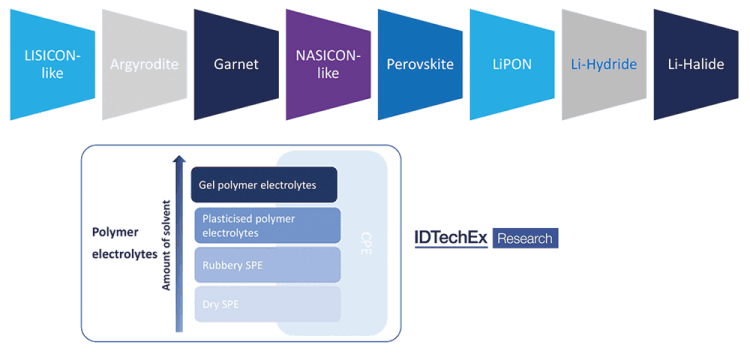
The current iteration of Li-ion batteries, which are based on graphite anodes, liquid electrolytes, and cathode materials such as NMC and LFP, are generally considered to be reaching their performance limits. However, from cell materials to battery designs, there are still several routes that can lead to further improvements in performance and cost.
The current iteration of Li-ion batteries, which are based on graphite anodes, liquid electrolytes, and cathode materials such as NMC and LFP, are generally considered to be reaching their performance limits. However, from cell materials to battery designs, there are still several routes that can lead to further improvements in performance and cost.
A shift from graphite to silicon
Promising significant improvements in energy density and performance, silicon anodes offer an exciting alternative to the incumbent graphite anodes used. While silicon material has been used in the anode in small quantities of <5 wt%, moving beyond its use as an additive has proved difficult due to its inherent volume expansion and resulting stability and cycle life issues. However, silicon anode technology has steadily improved over the past 10 to 15 years, allowing cells to use anywhere from 5 to 100% silicon in the anode.
New methods of cathode synthesis
Future Li-ion batteries are likely to use a similar suite of cathode materials that are commercially available today. LNMO or the LFP related LMFP could be considered exceptions, though neither would provide improvements to energy density but offer different trade-offs between high performance and low cost. Li-Mn-rich NMC cathodes could provide a modest increase in energy density, but commercial development is limited and slow. Improvements to cathode materials are generally going to be incremental. Instead, the largest shift in cathode technology and innovation could stem from how they are synthesised. Current synthesis techniques require high temperatures over relatively long periods of time (days) whilst also using high volumes of reagent and water, leading to high manufacturing costs and environmental impact. Nano One Materials and 6K Energy are two companies aiming to commercialise new ways of synthesising cathode materials.
Nano One Materials utilise a solution-based, ‘one-pot’ method to produce coated cathode materials. The company has a partnership with cathode manufacturer Pulead and entered into a development agreement with BASF earlier in 2022. 6K Energy utilises a microwave plasma reactor to produce its cathode materials, though they are also able to synthesise silicon anode and solid electrolyte materials as well.

Solid electrolytes and new electrolyte formulations
While solid electrolytes capture much of the attention regarding electrolyte technology, the use of new additives and electrolyte formulations can offer continued incremental improvements to liquid electrolyte systems. For example, New Dominion Enterprises are developing electrolyte additives and solvents based on phosphazenes and phosphorous-nitrogen compounds to help improve safety and performance. Specifically, their electrolyte additive materials can improve thermal stability, reduce vapour pressure and improve SEI formation. Long term, the company is aiming to completely replace the conventionally used organic solvent with their electrolyte system, with potentially significant improvements in safety.
Nevertheless, the holy-grail battery technology for many EV manufacturers remains the solid-state battery, which can offer significant improvements to safety by replacing the flammable liquid electrolytes currently used with a solid electrolyte. In addition, solid electrolytes also offer the potential for using lithium metal anodes, which could push energy densities beyond 1000 Wh/l. Challenges regarding the stability, cycle life, manufacturability, and even safety of solid-electrolyte systems mean the race continues between different electrolyte systems.
Space-efficient battery packs
For electric vehicles in particular, the design of the battery pack offers another key route to enhanced performance. Many automotive companies have announced batteries with cell-to-pack designs to eliminate materials associated with module housings and optimise packing efficiency, ultimately helping to improve energy density and improve battery integration into the vehicle. Earlier in 2022, CATL announced its LFP packs could reach 160 Wh/kg and 290 Wh/l, which starts to be competitive with its NMC counterparts. Maximising energy density can help to mitigate the primary disadvantage of cheaper LFP cells, offering a route to cheaper, long-range batteries. These types of battery designs, however, do come with the downside of reduced serviceability, which may limit their use in commercial vehicles.
More intelligent battery management systems
Improvements to battery management systems (BMS) can provide a route to improving multiple aspects of battery performance without the challenges associated with materials development. For example, Qnovo highlights how its BMS software and analytics can help simultaneously improve safety, cycle life, and charge time and increase the useable capacity of a battery. The company achieves this through a combination of battery use data and cell impedance measurements that inform physical models of Li-ion cells, which in turn are used to optimise operation and charging protocols.
Away from EVs, improved BMS would be highly valuable to other end uses, such as smartphones or power tools. The 1 to 100% charge in 19 minutes advertised by the OnePlus 10T is partly enabled by more intelligent charging algorithms, as well as more efficient thermal management. As well as this fast charge capability, OnePlus also advertises a cycle life of 1600 cycles, beyond the typical cycle life advertised for LCO and consumer electronics batteries. While cell developments often include trade-offs between the key performance characteristics of energy density, cycle life, fast charging, and safety, improvements to the BMS could feasibly offer improvements to all of them.
Ultimately, there are numerous routes to improve battery performance and cost. While some developments may only offer incremental benefits, their combination will allow Li-ion battery performance to continue its steady drive forward.

© Technews Publishing (Pty) Ltd | All Rights Reserved